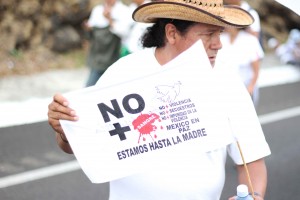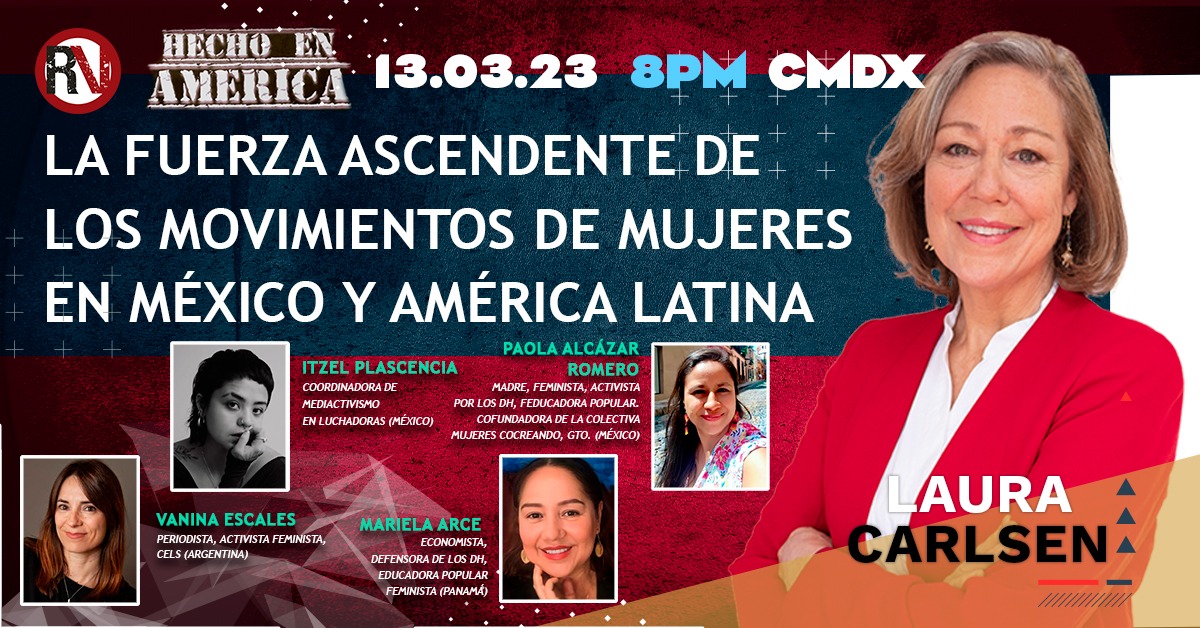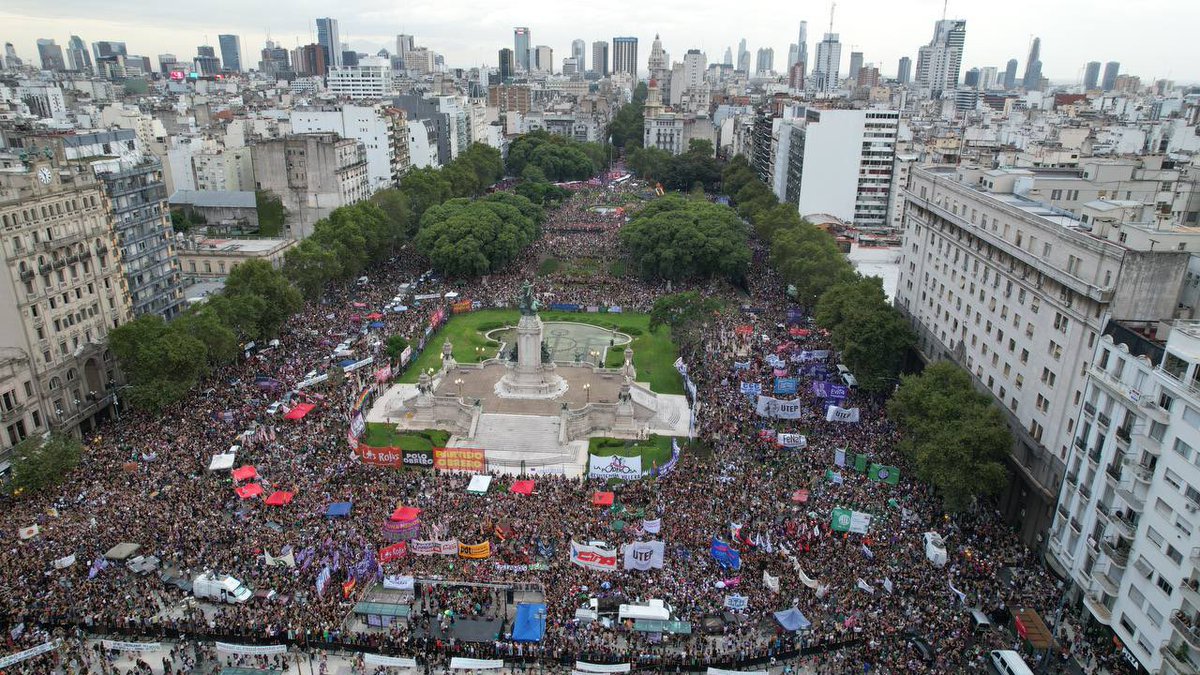Felipe Calderon is angry. Striking the podium, he insists that the explosion of violence in Mexico is the sole fault of organized crime. He reiterates his commitment to the war against drug trafficking, launched in December 2006, and to relentlessly pursue those responsible.
This vehement defense of his security strategy is directed not at the criminals themselves, but at a society in which the majority of the population increasingly rejects the president’s policy. On April 6, only a few days before the president was to address a group of entrepreneurs, tens of thousands of people took to the streets in over twenty Mexican cities in protest against “Calderon’s War” and against violence.
For Calderon, however, this new popular movement, under the banner NO + BLOOD, is misguided, politicized, and a betrayal of his pet cause. It is his view that those protesting should do so against organized crime, not against his government. In his speech, he accused the movement of using the language of peace to disguise a political attack on the Mexican government.
The thousands of youths, parents, indigenous women, and trade unions that participated in the protests do not see it that way. They do not dispute the fact that the brutality and audacity of the drug cartels are beyond the pale. Popular discontent, however, can be linked to one fact: In the years before Calderon launched his war, the number of homicides related to drug trafficking was approximately 2,000 per year (2,119 in 2006). In 2010, that figure reached 15,273.
The bloodshed in Mexico since 2007 cannot be measured only in the number of deaths. A recent report by the Monitoring Centre for Displaced Persons estimates that 230,000 people[1] have been forced to leave their homes due to threats and conflicts. There are approximately 10,000 orphans as a direct result of the violence. In the northern part of the country, the murder of women has increased sharply, as have other crimes against women, especially against human rights workers. Migrants have also fallen victim to the lucrative activities of the cartels, and an increase in kidnappings, extortion, and even recruitment of the migrants has been reported. The massacre of 72 migrants in San Fernando, Tamaulipas in April 2010 was the most shocking example of a phenomenon that has spread across the country.
The War that Isn’t a War
The resultant chaos of Calderon’s strategy is a result of its militarist focus and negligence in assessing its impact on the cartels. A few months ago, Calderon denied having ever used the word “war” to describe his strategy, leading the press to immediately dig through their files to produce scores of references to the “war” language.
Whatever one calls it, the basic premise of the strategy is to reduce supply by cutting off production in southern nations and attacking transit routes to the major market–the United States. Consequently, most of the resources and energy are geared towards confronting the traffickers and thus apprehending both the drugs and the leaders of the cartels. Over 50,000 Mexican soldiers have been deployed in this mission.
This has generated an explosion in violence in various forms that surpasses the mortality rate of many actual wars. The attack on one cartel only invites another to take its place, as the fight for available routes to supply the market is one of the main generators of the violence.
The violence is more complex and intense in areas where the State’s security forces have caused a fragmentation of the cartels. The collusion of politicians, police and military with the “enemy” has brought the violence into the public realm. Battles between the security forces and the cartels have taken place on the streets and resulted in the loss of civilian lives. There have been many reports of cases of violence and extortion by the security forces against civilians. Complaints of human rights abuses committed by security forces have increased six-fold in the last few years. These include extrajudicial executions, torture, sexual violence and disappearances. The war against drugs and the violence that accompanies it have made it impossible for certain parts of the country to be governed effectively. The result is a society dominated by fear, increased militarization and more powerful and brutal criminal organizations.
It seems incredible that the government still insists on claiming to be near victory in light of the statistics. Those in power seem to expect that the Mexican population will quietly accept 40,000 casualties as “collateral damage” in a war that seems to have no end. Calderon’s government cannot admit defeat after having invested so much political capital in the war on drugs, especially not in an election year.
Since the beginning, the war against drug trafficking has had other, non-disclosed, objectives. Calderon launched his war a few weeks after having become president, amidst massive protests and allegations of fraud that have never been resolved. The alliance between the army and the executive branch of government and the creation of a culture of fear of an external enemy – organized crime–served to consolidate his power despite the question of legitimacy. From its inception, the war has favored militarization above strengthening democratic institutions of the country. Military presence among civilian society serves to inhibit protest and erode civil liberties.
U.S. Support for the War
The U.S. government, first under George W. Bush and now under Barack Obama, plays a crucial role in sustaining Calderon’s war with resources, training, and declarations of support. The war on drugs has been a dream come true for the Pentagon, allowing military strategists to fulfill objectives defined since the Security and Prosperity partnership of NAFTA was designed and signed in 2005.
Washington has been pushing for closer military ties with Mexico since the Security and Prosperity Partnership of North America (2005) in order to protect its political and economic interests in those countries immediately bordering the USA. The Merida Initiative objectives involved cooperation against terrorism, against drugs, and securing all national borders. The initiative includes provision of military and spying equipment to Mexico in order to increase territorial security and the subsequent militarization of the country. It was presented as a “shared responsibility” between the countries, and resulted in a series of programs being enacted in Mexico, without parallel measures being taken to tackle the problem of ultimate destination of the drugs: the USA.
Mexico’s government, until the Merida Initiative, rejected the interference of its powerful neighbor in matters of national security. Since then, the Initiative, extended indefinitely by the Obama government, has ushered in a period of US interference without precedent. It follows the model of the Plan Colombia, which has produced over a decade of militarization of that nation and the continued military presence of the USA on Colombian soil. There too, there are increased violations of human rights, population displacements, and appropriation of natural resources. Behind the rhetoric of the war against drugs, the aims of the Initiative are:
- To protect the economic interests and investments of the United States and to gain access to the natural resources of Mexico
- Impose the National Security Doctrine devised by the Bush administration which allows for the military presence – or the threat thereof – of the USA anywhere in the world in order to guarantee the stability of the system and thus to fold Mexico into the security zone of the USA
In practical terms, the Initiative breaks down the barriers that had been maintained throughout history by various Mexican administrations to ensure Mexican sovereignty.
To date, more than $1.5 billion has been given to Mexico in the war against drugs. Furthermore, the relationship between the two countries with respect to security issues has been redrafted. The majority of the resources has been spent on military equipment and services for the army, the police and the intelligence agencies. The relationship between the countries is being defined and controlled by the Pentagon and the North and South Command, with the support of the State Department, all under the contextual umbrella of “regional security”.
The increased presence of the US security agencies has disturbing consequences for the sovereignty of Mexico. It is vitally important to clarify how the drug cartels, redefined as narco-insurgents, pose a territorial threat to the United States. For it is under this banner – insurgency – that the increased militarization is occurring, echoing the way in which Plan Colombia was expanded by the Congress of the United States by using the term “insurgency”. Many Mexican human rights organizations have documented the increased criminalization of the protest movement and the repression of any opposing political parties. The stance of the USA not only endorses this process but advocates this violent war despite undeniable evidence as to its negative effects on the general population.
But there is another reason why it is in the interest of United States to continue propagating this war. The terms of the Merida Initiative do not allow for hard cash to be handed over to the Mexican government. The contracts financed by the Merida Initiative have been awarded to American arms manufacturers with powerful lobbies in Washington and a hunger to open a new market in the south. Companies such as Boeing and Lockheed, which sell airplanes and helicopters worth millions of dollars, and private security firms such as Blackwater and Dyncorp which offer training and recruitment services, see the Mexican situation as a way to expand their businesses. Some of these companies have been involved in the deaths of civilians and have been criticised for their financial and operational irregularities and lack of transparency. Their Merida Initiative funded contracts are yet another threat to Mexican human rights and present a danger to the strengthening of the democratic process and its institutions. There are no means by which the Mexican state can police or regulate the foreign privatizing of its security. In other words, these companies benefit from the same nonliability as the criminals.
There are Other Ways
The counterproductive impact of the war against drugs on society is undeniable. Statistics notwithstanding, the pain of the families of victims and the culture of fear have warped the future of the youth of Mexico. Opinion polls[2] show an important change: the majority of the population no longer believes that the government is prevailing and thus does not support the strategy.
Even Calderon has succumbed to the obvious and has recently dropped the oft repeated message that Mexico is winning the war. His credibility problems mounting, he has said that there is no other alternative and has challenged his critics to come up with a better solution.
The government of the United States, meanwhile, is also beginning to express doubts about the strategy. Wikileak cables show that the US embassy in Mexico were concerned at high levels of corruption and the inefficiency of not only the security forces but also in all three branches of the Mexican government, questioning in particular the focus placed on capturing the drug barons. The latest version of the Merida Initiative, known as Merida II, presented recently by the Obama government, contains less military support and more training and encouragement for reform of the judiciary and the police. Nevertheless, financial assistance is still being allocated to militarily controlling the drug trade without a significant increase in financing social programs. Neither does it address the basic problems within the United States, the source of both the arms and the capital fueling the drug trade. The efforts made by both governments to reiterate and consolidate the bilateral support for the war and at the same time trying to redefine its image, amount to an admission of failure. Concurrently, those opposed to the war are intensifying their protests and are responding to Calderon’s challenge by offering alternative non- violent solutions to scourge of organized crime. Some of these have been proposed by the poet Javier Sicilia, whose son was murdered. His tragedy has inspired a new wave of mobilizations across the country.
The first proposal is to treat the demand for drugs as a health problem, prioritizing prevention, rehabilitation, treatment, and the minimization of side effects not only in Mexico, but mainly in the United States, where the government is seen to have shirked its responsibilities in this regard. There is a great need for youth education to promote an understanding of the dangers of addiction and employment opportunities to provide them with something to take its place. It is a logical solution that ensures quality of life thus reducing demand for drugs.
Secondly, the quickest and most effective way to reduce the demand for illicit drugs that enrich criminals, is to legalize them, starting with marijuana. This proposal is garnering support among both the experts and the general public and merits greater study and debate.
Thirdly, it is imperative that the financial structures that enable laundering of the proceeds of organized crime be dismantled.
And finally, it is important to recognize, support and protect those grassroots projects springing up in places such as Ciudad Juarez that offer society a role other than that of victim. When the police and military are the sole tool used to combat crime, the population is marginalized and exposed to abuse, with a resultant situation resembling a domestic invasion, or a military/police state, with a complete abandonment of human and civil rights.
An active and strong society is much more capable of resisting and fighting organized crime. Stable communities–with employment, adequate housing, education, safe and orderly leisure and public spaces–can defend themselves while ensuring the health of democratic institutions.
Laura Carlsen is director of the Americas Program of the Center for International Policy in Mexico City.
This article was first published in issue #464 of América Latina en Movimiento.
Translated by Isabella Weibrecht
[1] http://mexico.cnn.com/nacional/2011/04/07/los-desplazados-en-mexico-en-
busca-de-un-hogar-para-huir-de-la-violencia
[2] http://www.consulta.mx/Estudio.aspx?Estudio=percepcion-seguridadmx-2010




